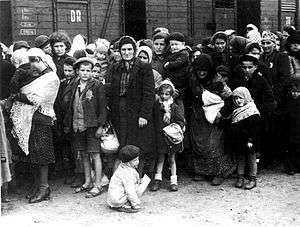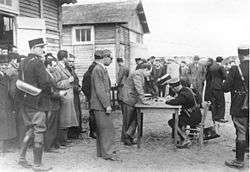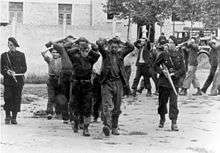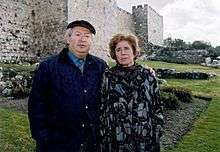Camp de Rivesaltes
| Part of a series on | ||||||||||
| The Holocaust | ||||||||||
|---|---|---|---|---|---|---|---|---|---|---|
 | ||||||||||
|
||||||||||
|
Atrocities |
||||||||||
|
Camps
|
||||||||||
|
Lists Deportations of French Jews
to death camps |
||||||||||
|
Remembrance |
||||||||||
The Camp de Rivesaltes, also known as Camp Maréchal Joffre, is a military camp in the commune of Rivesaltes nearby Perpignan in the department of Pyrénées-Orientales in the South of France. The camp was also used to detain civil populations several times between 1939 and 2007. Its darkest period was in 1942, when 2,251 Jews, including 110 children, were transferred from Rivesaltes via the Drancy internment camp to the Nazi extermination camp Auschwitz, where they were murdered.
History
In 1935, the commune of Rivesaltes, situated on a rail route 40 km from the Spanish border, was considered a strategic position for the French army, which took over 612 hectares between Rivesaltes and Salses, 5 km from the city of Rivesaltes, to construct a camp. It was originally intended to be used as a military base. At the same time, southern France became a major haven for Jewish refugees attempting to flee to neutral countries, whether legally or illegally.
Creation (1938–1940)

The military camp was built in 1938, a few miles from Perpignan. Four-fifths of the camp was situated within the commune of Rivesaltes and one-fifth within the commune of Salses. The camp was named "Camp Joffre" after General Joseph Joffre, the commander-in-chief of the French army during World War I.[1]
Following the Retirada (the exodus of about half a million refugees from Spain to France in early 1939 during the Spanish Civil War[2]), the French government decided to use Camp Joffre to intern more than 15,000 Catalan refugees. This decision was never fully put into action, although a small influx of Catalan refugees was held there in 1939.
On December 10, 1940, the Ministry of Defense set aside 600 acres (2.4 km2) south of the camp to house people expelled from Germany. The military camp was then run in parallel with the civilian camps.
In 1939, at the start of World War II, the camp became a military transit base, and in 1940 a refuge for Spanish refugees fleeing the Franco dictatorship. After the signing of the armistice, France was split into two. The zone libre ("free zone"), in which the Pyrénées-Orientales was included, came under the administration of the Vichy government.
Gradually, the Joffre camp became a place of internment for families of gypsies, Jews and Spanish refugees. With a capacity of 8000, before long the camp became overcrowded, families were separated, and conditions deteriorated greatly.
Accommodation center (1941–1942)

When the first internees arrived on January 14, 1941, the status of the camp was not yet settled. It was decided to make it an "accommodation center" for families. Initially planned for a maximum of 17,000 "guests", it included 150 large barracks with a capacity of 10,000 individuals. Families were divided between barracks: there were barracks for men, others for women and children. By May 31, 1941, the camp had 6,475 internees from 16 nationalities; Spaniards constituted more than half of them, and Jewish refugees from other countries more than a third.
Transit camp (1942)


At five o'clock in the morning on August 26, 1942, the foreign Jews in the southern zone were rounded up and taken to the Centre national de rassemblement des Israélites at Rivesaltes. This "center" was newly established in the camp, in blocks J (for women and children), F (for men; this block had previously been reserved for workers) and K (reception, screening and sorting). It was planned as a transit camp for a total of 10,000 internees who would be housed there for 15 days before being deported. The 1,176 Jews already in the camp prior to the round-up were included in this count.
Convoys left Rivesaltes for Drancy internment camp on August 11 (400 people), August 23 (175 people), September 1 (173 people), September 4 (621 people), September 14 (594 people), September 21 (72 people), September 28 (70 people), October (101 people) and October 20 (107 people).
Serge Klarsfeld called the Rivesaltes camp "the Drancy of the free zone", noting that from September 4 to October 22 it played the same role as the Drancy camp in the occupied zone: a transit camp for deportees whose ultimate destination was the Nazi extermination camps. Rivesaltes was, during that time, the camp where the Jews arrested in the so-called "free zone" were gathered, and from which many of them (about 1,700) were sent to Drancy itself.[3]
In November 1942, as Germany invaded the previously unoccupied southern zone of France, German troops moved into Camp Joffre, and it was closed as an internment camp on November 25. There were 277 staff members when it closed.
During those two years, the camp of Rivesaltes housed about 21,000 internees; about 5,714 of them were interned in the "special camp" or transit camp, of whom 2,313 were sent to Drancy and 2,251 were excluded from deportation by the screening committee. A further 215 internees died in the camp, including 51 children one year old or younger.
Guarded residence center (1944–1946)
The German army left Rivesaltes on August 19, 1944. While the military part of Rivesaltes camp resumed its original purpose, a new "guarded residence center" was established there on September 12, 1944. Located chiefly in block Q, this center housed people interned under the Vichy regime's épuration ("purification") policy. It had a maximum capacity of 1,080 internees.
The center continued to receive people from other European countries: Spaniards interned for crossing the border illegally were put to work to secure the center, and in January and March 1945 several hundreds of Soviet prisoners of war arrived.
The closing of the center was decided upon on December 10, 1945, and completed early in October 1946.
Prisoner-of-war depot (1944–1948)
The military authority transformed the camp into Depot No. 162 for prisoners of war. Housing mostly German and Italian soldiers, this camp held less than 10,000 prisoners in October 1944, and between 6,000 and 7,000 men in May 1945. It closed on May 1, 1948. The prisoners worked extensively on the reconstruction of the Roussillon region. Between May 1945 and 1946, 412 German prisoners of war died in the camp.
Post Second World War
This facility continued to be used after the events of the Second World War. The Algerian war was the next opportunity to use the facility to detain people.
Algerian war (1962)
Under the stiffening of the French state caused by the Algerian War, the French government planned in 1957 to create an internment camp on the site. The Prefect tried to dissuade them because, in addition to a training center populated mainly by North Africans, the site contained a Professional Military Training Center particularly for North Africans and young soldiers mobilized for war. The plan was not carried out in its entirety, but a prison was set up discreetly for people convicted of being supporters of Algerian independence, and 527 prisoners were held there between March 9 and April 18, 1962.
Transit and rehabilitation camp (1962–1977)
Harkis
Harkis is the generic term for Muslim Algerians serving as auxiliaries with the French Army during the Algerian War (1954–1962).
In June 1962, the 1st regiment of Algerian riflemen was repatriated to Camp Joffre. They brought with them hundreds of civilians, women and children running away from the new independent Algeria. In October 1962, about 8000 Harkis were staying at the transit and rehabilitation camp of Rivesaltes (including those from the camp of Larzac and Bourg-Lastic). In all, according to the calculations of Abderahmen Moumen, about 20,000 people passed through and accumulated in the camp from 1962 to 1964. The stay varied from a few days for some families to years for others.
Families considered "irretrievable"—a term used by administrators at the time—were sent at the end of 1964 to the Saint-Maurice-l'Ardoise military camp in the Gard until 1975. Several hundred more families who had employment but no housing were accommodated in a "civil village" in the Rivesaltes camp during the 1960s. In 1963, a forestry village was also created in Rivesaltes for about 25 families of former auxiliaries (about a hundred people). The next decade saw the bulk of this population moved to the HLM (rent-controlled housing) of Rearte, built in the city of Rivesaltes to finalize the situation of these families. The last residents left the camp in February 1977.
Colonial auxiliaries
Other French Colonial Forces and auxiliaries from Africa and French Indochina came, accompanied by civilians, with the decolonization of the French colonial empire: from 1964 to 1966 about 600 Guineans arrived, and other former soldiers and their families came from French Indochina.
Immigration detention center (1986–2007)
Created in 1986, the administrative detention center was set up to detain Spanish nationals who had entered French territory illegally. With more than a thousand arrested on French soil in 1994, it was one of the largest detention centers in France. It was closed in 2007.
The Rivesaltes memorial museum

French Name: Mémorial du Camp de Rivesaltes
The memorial museum project has its origins in Serge Klarsfeld's 1978 publication of the list of deported Jews and Jews who died in the camp of Rivesaltes.
- In 1993, Klarsfeld published "The transfer of Jews from the camp of Rivesaltes and the Montpellier area towards the center of Drancy for deportation on August 10, 1942."
- On January 16, 1994, Klarsfeld's association "Sons and daughters of Jews deported from France" erected a monument to the memory of 2,313 Jews deported from the Rivesaltes camp to Auschwitz.
- On December 2, 1995, a monument to the Harkis was installed.
- In 1997, a collective petition "To the living memory of the camp of Rivesaltes" was signed by Simone Veil, Claude Simon, Edgar Morin and many citizens to protest against threats to destroy the camp.
- In 1998, Christian Bourquin, the new president of the General Council of the Pyrénées-Orientales, opposed the destruction of the site and started public consultations on the project.
- On October 30, 1999, a stele was erected in memory of the Republicans of the Spanish Civil War.
- In 2000, the French Ministry of Culture included the site in its supplementary list of Monuments historiques.[4]
- In 2005, on the French Heritage Day, part of the camp was opened to the public for the first time.
- Rudy Ricciotti won the architecture competition.
- Robert Badinter agreed to sponsor the project.
- In November 2005, the General Council of the Pyrénées-Orientales acquired F block, about 42 hectares.[5]
- On January 21, 2009, architect Rudy Ricciotti filed the construction permit. Work was expected to start in 2010 and take two years.[6][7]
- In October 16, 2015, inauguration by Prime Minister Manuel Valls.
See also
References
- ↑ Kate. "Rivesaltes internment camp - camp Joffre". Anglophone-direct. Retrieved 2016-03-16.
- ↑ Howitt, Basil, (2009). "La Retirada". Lest We Forget.
- ↑ Klarsfeld, Serge (2001). "L'acheminement des Juifs de province vers Drancy et les déportations". Ahicf.com. Retrieved 2016-03-16.
- ↑ https://web.archive.org/web/20110610130613/http://www.culture.fr/fr/sections/regions/languedoc_roussillon/organisme/JEP-ORGS168639?typeSearch=SearchableTextagencies&=&=SearchWhere. Archived from the original on June 10, 2011. Retrieved April 9, 2009. Missing or empty
|title=(help) - ↑ https://web.archive.org/web/20090410052728/http://www.cg66.fr/culture/memorial/index.html. Archived from the original on April 10, 2009. Retrieved April 8, 2009. Missing or empty
|title=(help) - ↑ "L'architecte Rudy Ricciotti construira le mémorial du camp de Rivesaltes : 03-01-2006". Batiweb.com. Retrieved 2016-03-16.
- ↑ (PDF) https://web.archive.org/web/20090106053352/http://www.cg66.com/culture/memorial/revue_presse/RP_avril_mai_08.pdf. Archived from the original (PDF) on January 6, 2009. Retrieved April 8, 2009. Missing or empty
|title=(help)
Further reading
- Anne Boitel, Le Camp de Rivesaltes 1941-1942, Presses Universitaires de Perpignan, Mare Nostrum, Perpignan, 2001.
- Joël Mettay, L’Archipel du mépris, Trabucaire, Perpignan, 2001.
- Abderamen Moumen, Entre histoire et mémoire. Les rapatriés d'Algérie. Dictionnaire bibliographique, Gandini, Nice, 2003.
- Denis Peschanski, La France des camps, Gallimard, Paris, 2002
- Rosemary Bailey, Love and War in the Pyrenees, Orion Books, 2008
External links
- Memorial of the Camp of Rivesaltes
- Camp of Rivesaltes (jewishtraces.org)
- History and visiting information (French)
- Link Camps of SW France
Coordinates: 42°48′03″N 2°52′13″E / 42.80083°N 2.87028°E
